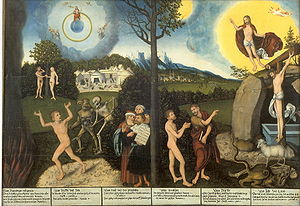| Part of the series on Lutheranism | |

| |
| Luther's Seal | |
| History | |
|---|---|
|
Christianity | |
| People | |
|
Martin Luther · Philipp Melanchthon | |
| Book of Concord | |
|
Augsburg Confession | |
| Theology and Sacraments | |
|
Evangelical Catholic · Law and Gospel | |
| Liturgy and Worship | |
| Denominations | |
|
Lutheran World Federation | |
| Lutheranism | |||||
|---|---|---|---|---|---|

| |||||
| Luther's Seal | |||||
| |||||
| |||||
| |||||
| |||||
| |||||
| |||||
| |||||
| Lutheranism portal | |||||
In Christianity the relationship between God's Law and the Gospel is a major topic in Lutheran and Reformed theology. In these traditions, the distinction between the doctrines of Law, which demands obedience to God's ethical will, and Gospel, which promises the forgiveness of sins in light of the person and work of Jesus Christ, is critical. It is used as a hermeneutical principle of biblical interpretation and a guiding principle in homiletics (sermon composition) and pastoral care. It aims at the subordination of the Halakah, the collective body of Jewish religious law, or in general Judaism, under the dominance of Christian theology and the New Covenant.
Other Christian groups have a view on the issue as well, though it has not usually been as hotly debated or rigorously defined as in the Lutheran and Reformed traditions.
Sometimes the issue is discussed under the headings of "Law and Grace," "Sin and Grace," "Spirit and Letter," and "ministry (διακονíα) of death/condemnation" and "ministry of the Spirit/righteousness".[1] Sometimes it is considered in the contrast between Moses and Jesus Christ.[2]
Lutheran view[]
Martin Luther and Lutheran theologians[]
A specific formulation of the distinction of Law and Gospel was first brought to the attention of the Christian Church by Martin Luther (1483-1546), and laid down as the foundation of evangelical Lutheran biblical exegesis and exposition in Article 4 of the Apology of the Augsburg Confession (1531): "All Scripture ought to be distributed into these two principal topics, the Law and the promises. For in some places it presents the Law, and in others the promise concerning Christ, namely, either when [in the Old Testament] it promises that Christ will come, and offers, for His sake, the remission of sins justification, and life eternal, or when, in the Gospel [in the New Testament], Christ Himself, since He has appeared, promises the remission of sins, justification, and life eternal." [3]. The Formula of Concord likewise affirmed this distinction in Article V, where it states: "We believe, teach, and confess that the distinction between the Law and the Gospel is to be maintained in the Church with great diligence. . ."[4]
Martin Luther wrote: "Hence, whoever knows well this art of distinguishing between Law and Gospel, him place at the head and call him a doctor of Holy Scripture."[5] Throughout the Lutheran Age of Orthodoxy (1580-1713) this hermeneutical discipline was considered foundational and important by Lutheran theologians. Carl Ferdinand Wilhelm Walther (1811-1887), who was the first (and third) president of the Lutheran Church - Missouri Synod, renewed interest in and attention to this theological skill in his evening lectures at Concordia Seminary, St. Louis 1884-85.[6]
The Book of Concord[]
The Formula of Concord distinguished three uses, or purposes, in the Law in Article VI. It states: "[T]he Law was given to men for three reasons. . ."
- That "thereby outward discipline might be maintained against wild, disobedient men [and that wild and intractable men might be restrained, as though by certain bars]"
- That "men thereby may be led to the knowledge of their sins"
- That "after they are regenerate. . .they might. . .have a fixed rule according to which they are to regulate and direct their whole life"[7]
We may summarize the three uses as follows:
- To restrain external evil (civil use) or (curb).
- To show us our sin (pedagogical, theological, or elenchtical {convicting} use) or (mirror).
- To show us God's character and will as a rule and guide to holy living, empowered by the Gospel alone (didactic use) or (rule).
Reformed view[]
In his Institutes of the Christian Religion, the Reformer John Calvin likewise distinguished three uses in the Law. Calvin wrote: "That the whole matter may be made clearer, let us take a succinct view of the office and use of the Moral Law. Now this office and use seems to me to consist of three parts."[8]
- By "exhibiting the righteousness of God, — in other words, the righteousness which alone is acceptable to God, — it admonishes every one of his own unrighteousness, certiorates, convicts, and finally condemns him."[9]
- It acts "by means of its fearful denunciations and the consequent dread of punishment, to curb those who, unless forced, have no regard for rectitude and justice."[10]
- "The third use of the Law. . .has respect to believers in whose hearts the Spirit of God already flourishes and reigns. . . . For it is the best instrument for enabling them daily to learn with greater truth and certainty what that will of the Lord is which they aspire to follow, and to confirm them in this knowledge. . ."[11]
This scheme is the same as the Formula of Concord, with the exception that the first and second uses are transposed.
Roman Catholic view[]
The view of the Roman Catholic Church on this issue is expressed in the bull Unam Sanctam, where Pope Boniface theorizes the two swords doctrine : the sword of the Gospel is weighed by the Church, while the sword of the law or temporal sword is under the authority of the State. However, the Gospel sword is higher and mightier than the temporal sword, meaning that all laws should ideally be in conformity with the norms established by the corporate gospel Church.

Law and Grace, by Lucas Cranach the Elder, a Lutheran. The left side of the tree illustrates law, while the right side illustrates grace
Lutheran and Reformed differences[]
There has been significant dispute in Lutheran and Reformed camps over the extent to which the first use (or second use in the Reformed scheme) remains valid outside of the original Jewish social context in which the Law was given. In other words, which parts of the Law (which is sometimes divided into moral, civil, ceremonial portions), remain binding on societies today (for the general discussion, see Biblical law in Christianity).
Additionally, some have suggested that the third use of the law is not found at all in Luther but comes from Melanchthon. Although some Lutherans have rejected that view,[12] it has caused others to dispute the validity of the "third use" of the Law. Paul Althaus, for instance, writes in his treatise on Law and Gospel: "This [ethical] guidance by the Holy Spirit implies that God's concrete commanding cannot be read off from a written document, an inherited scheme of law. I must learn afresh every day what God wants of me. For God's commanding has a special character for each individual: it is always contemporary, always new. God commands me (and each person) in a particular way, in a different way than He commands others.... The living and spiritual character of the knowledge of what God requires of men in the present moment must not be destroyed by rules and regulations."[13] Such theologians believe the third use leads to or encourages a form of legalism and is possibly an implicit denial of sola fide.
Conversely, Reformed Christians have sometimes seen this two-use scheme of some modern Lutherans as leading to a form of antinomianism. Historically, Reformed Christianity itself has argued either that the moral law (especially as it is summarized in the Ten Commandments) remains in effect, while the civil and ceremonial laws have been abrogated[14] or that the entire law is in force, but the way in which we keep it has been modified.[15] Other Reformed Christians known as theonomists or Christian Reconstructionists have argued that the civil laws of the Old Testament should also be enforced today. Both parties operate to some extent by modified application of the Law, but the theonomists tend more toward literal application of it.[16]
Some believe that "for Luther the pedagogic use of the Law was primary, while for Calvin this third or didactic use was the principal one; yet [historically] both the Lutheran and the Reformed traditions maintain the threefold conceptualization."[12]

Law and Grace, a woodcut by Lucas Cranach the Elder, a Lutheran. The left side of the tree illustrates law, while the right side illustrates grace
Notes[]
- ↑ 2 Cor. 3:6-9.
- ↑ John 1:17.
- ↑ F. Bente and W.H.T. Dau, ed. and trans. Triglot Concordia: The Symbolical Books of the Evangelical Lutheran Church, (St. Louis: Concordia Publishing House, 1921), Apology IV (II).5, p. 135
- ↑ Triglot Concordia, FC Epitome V, (II).1, p. 503ff
- ↑ Martin Luther, Dr. Martin Luthers Sämmtliche Schriften, St. Louis ed. (St. Louis: Concordia Publishing House, N.D.), vol. 9, col. 802.
- ↑ The Proper Distinction Between LAW AND GOSPEL: 39 Evening Lectures, W.H.T. Dau tr., 1897.
- ↑ Triglot Concordia, Epitome VI (I)
- ↑ Inst. 2.7.6
- ↑ Inst. 2.7.6
- ↑ Inst. 2.7.10
- ↑ Inst. 2.7.12
- ↑ 12.0 12.1 "The Third Use of Law" by John Warwick Montgomery in Present Truth, vol. 7
- ↑ Paul Althaus, The Divine Command, pp. 43, 45
- ↑ See Westminster Confession of Faith, chapter 19
- ↑ "Laws in Effect Today" by Ra McLaughlin
- ↑ "Are All Reformed Christians Theonomists?" by Ra McLaughlin
See also[]
- Law in Christianity
- Doctrine of the two kingdoms
- Salvific Law
- Lutheran
- Reformed
- Theonomy
- Legalism
- Antinomianism
- Biblical Evangelism
- Expounding of the Law
- Great Commission
- Noahide Laws
- Proselyte
- Joint Declaration on the Doctrine of Justification
Books[]
Lutheran
- F. Bente and W.H.T. Dau, ed. and trans. Triglot Concordia: The Symbolical Books of the Evangelical Lutheran Church St. Louis: Concordia Publishing House, 1921. [1]
- Paul Althaus, The Divine Command: a New Perspective on Law and Gospel. Trans. Franklin Sherman. Philadelphia: Fortress Press, 1966.
Reformed
- Stanley N. Gundry, ed. Five Views on Law and Gospel. Grand Rapids, MI: Zondervan, 1996.
- John Murray. Principles of Conduct: Aspects of Biblical Ethics. Grand Rapids, MI: Eerdmans, 1957.
- Greg L. Bahnsen. Theonomy in Christian Ethics. S.L.: Covenant Media Press, 2002.
External links[]
- Five Views on Law and Gospel, ed. by Stanley N. Gundrey
- Law in Luther And Calvin, by Edward A. Dowey
- The Struggle to Balance Law & Grace, by Bernie L. Gillespie
- The Christian and the Moral Law - Link list at the-highway.com
Lutheran[]
- Hummel, Horace D. "Are Law and Gospel a Valid Hermeneutical Principle?" [online]Concordia Theological Quarterly 46 (1982) no. 2-3:181-207. Available from <http://www.ctsfw.edu/library/files/pb/1571>[2]
- Klug, Eugene F. "Confessional Emphasis on Law and Gospel for Our Day" [online]Concordia Theological Quarterly 42 (1978) no. 3:241-257. Available from <http://www.ctsfw.edu/library/files/pb/1704>[3]
- Lueker, Erwin L. Law and Gospel from the Christian Cyclopedia. Concordia Publishing House, 2000.
- Rosenthal, Shane Law & Gospel.
- Using the Third Use: Formula of Concord VI and the Preacher's Task
- Walther, C.F.W. Law and Gospel, (excerpts).
- Walther, C.F.W. The Proper Distinction between Law and Gospel, (complete work).
- Bucholtz, Jon D. "Justification: Handling the Word of Truth, part 3 of 5." Forward in Christ, April 2006. WELS publication, Accessed April 17, 2006.
- Scholarly articles on Law and Gospel from the Wisconsin Lutheran Seminary Library
Reformed[]
- "Law and Grace", sermon by C. H. Spurgeon
- "God's Law in Man's Heart", sermon by C. H. Spurgeon
- "Law and Grace" by John Murray
- "Law and Gospel", by John Frame
- "Calvin & The Law-Gospel Hermeneutic" by Michael Horton
- "What's Really at Stake?", by Michael Horton
- "Calvin’s Third Use of the Law: An Assessment of Reformed Explications of the Ten Commandments" by John Burgess in PDF
- "Michael Horton, John Calvin, and 'Law & Gospel'", by Bill DeJong
- "Mixing 'Law' and Gospel in the Abrahamic Promise", by Mark Horne
- Law and Liberty, Law and Gospel extensive link list at monergism.com
- Some or all of this article is forked from Wikipedia. The original article was at Law and Gospel. The list of authors can be seen in the page history.